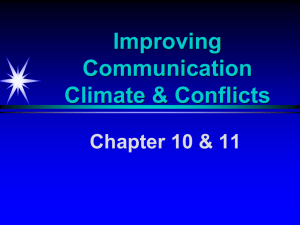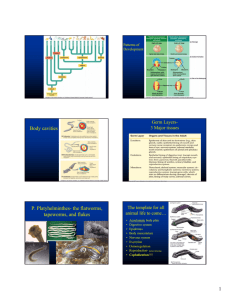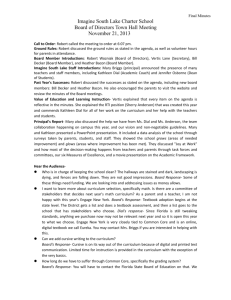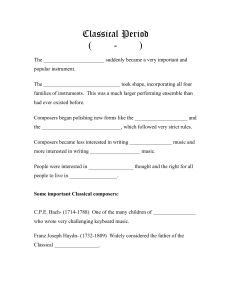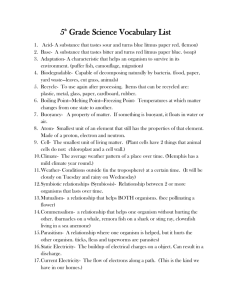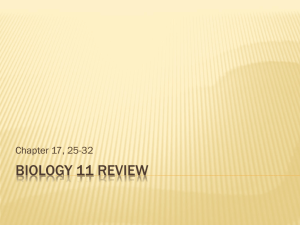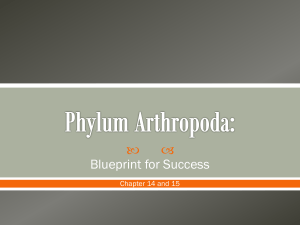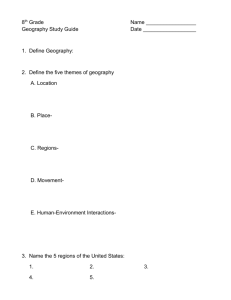Invertebrates
advertisement
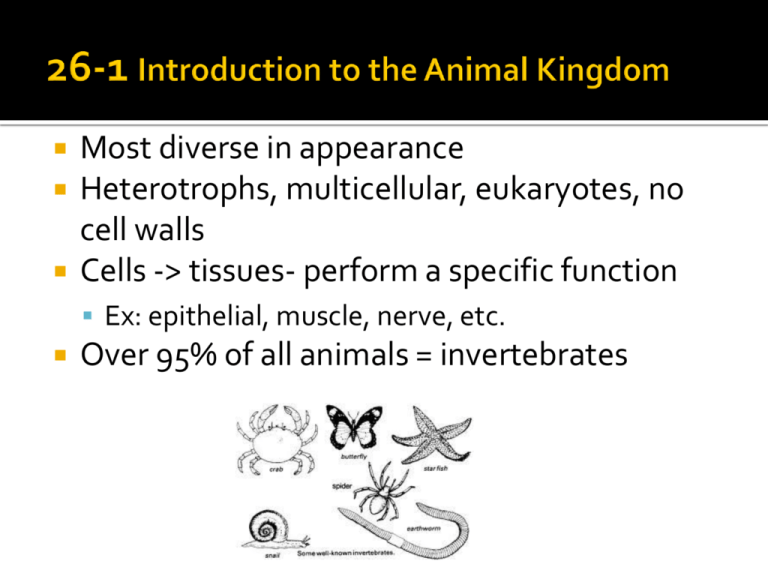
Most diverse in appearance Heterotrophs, multicellular, eukaryotes, no cell walls Cells -> tissues- perform a specific function Ex: epithelial, muscle, nerve, etc. Over 95% of all animals = invertebrates Things look the way they do in order to perform a certain function Study of these functions: physiology Homeostasis Feedback inhibition: product (result) of a process stops/limits the process ▪ (ex: dog panting) 1. feeding- ingest nutrients 2. respiration- O2 in / CO2 out 3. circulation- nutrients/gases/waste 4. excretion- get rid of wastes 5. response- receive/process info + react 6. movement- motility + feeding 7. reproduction- sexual: increase genetic diversity asexual: increase population #s Most complex animals have: increase specialization bilateral symmetry cephalization w/ sense organs body cavity (coelom) Blastula: protostome vs. deuterostome Germ layers Endoderm (inner) Mesoderm (middle) Ectoderm (outer) Body symmetry Radial/ bilateral Anterior/posterior Dorsal/ventral Dissecting pan Pins Scissors Probe Hand lens Forceps Scalpel/blade Apron Goggles Gloves Chapters 26, 27 & 28 Sea sponges Sessile- don’t move Very different from other animals Very few specialized cells Choanocytes: specialized cells- use flagella to move water inside open body cavity Osculum: large opening where water leaves Feeding- filter feeders Resp/Circ/Excr- water movement Response- can secrete toxins to ward off predators Reproduction- sexual (larva) and asexual (budding or gemmules) Soft bodies Carnivores Stinging tentacles Ex: jellyfish, hydras, sea anemones, corals Cnidocytes: stinging cells Nematocysts: poison-filled stinging structure Radial symmetry Polyp vs. medusa stages Feeding- gastrovascular cavity (one opening) Resp/Circ/Excr- diffusion Response-nerve net: network of nerve cells that react to stimuli Movement- hydrostatic skeleton Reproduction- asexual (budding) and sexual (separate sexes) flatworms Acoelomates Bilateral symmetry Cephalization Ex: flukes, tapeworms Feeding: Free-living: 1 opening digestive cavity ▪ Pharynx extends out- brings food in Parasitic: eat digested food Resp/Circ/Excr- diffusion Flame cells: remove excess water/waste Response- ganglia: group of nerve cells Eyespot: detect light Movement- cilia and muscles Reproduction- sexual (hermaphrodites) asexual fission: organism splits in two Roundworms Pseudocoelomates C. elegans- 1st organism to have its entire genome sequenced! Feeding- 2 openings in digestive tract mouth and anus Resp/Circ/Excr- diffusion Response- ganglia + nerves run length of body Movement- hydrostatic + muscles along body Reproduction- sexual (separate sexes) Trichinosis- burrows in organs- painful Filarial- elephantitis swelling Ascarid- parasitic- causes malnutrition Hookworms- enter blood stream and intestines- cause weakness and poor growth Ringed worms Segmented bodies separated by septa Some segments specialized Coelomates Ex: earthworms, leeches Feeding- pharynx or filter feeders Crop (stores food) and gizzard (breaks it down) Circulation- closed (dorsal and ventral vessels) Respiration- gills or moist skin (diffusion) Excretion- anus and nephridia (cellular waste) Response- well-developed brain Movement- specialized muscles Longitudinal and circular Reproduction- most sexual (some hermaphrodites) Soft-bodied Usually have a shell (internal/external) VERY diverse Ex: snails, slugs, clams, squid, octopus Share similar developmental stages coelomates Main Parts: 1. foot- used for crawling, hunting, burrowing, etc. 2. mantle- covers body like a coat 3. shell- glands secrete calcium carbonate 4. visceral mass- internal organs Feeding- radula, jaws, siphon Respiration- gills, moist mantle Circulation- open or closed Excretion- nephridia Response- from ganglia -> highly developed brains (octopus) Movement- secrete mucus, jet propulsion Reproduction- external/internal, separate sex/hermaphrodites 3 types: Gastropod (snails) Bivalves (clams) Cephalopods (octopus) Human uses: Filter feeders build up high concentrations of pollutants- scientists can use to monitor water Some snails don’t get cancer- use for research “jointed foot” Most diverse and successful phylum Ex: crabs, spiders, horseshoe crabs and insects Segmented body # varies Tough exoskeleton Chitin Varies in texture (leathery, waxy, hard) Jointed appendages Evolution- decreased # of segments, specialized appendages Feeding- mouthparts vary Suckers, filters, fangs etc. Respiration- tracheal tubes Use of spiracles, book lungs, gills Circulation- open system- heart Excretion- Malpighian tubules N wastes into feces (land) or water (aquatic) Response- brain->nerve cord->ganglia in appendages Movement- muscle cells contract- pull on exoskeleton to fly, swim, walk , etc. Reproduction- land= internal fertilization Aquatic= external or internal Molting: shed exoskeleton and grow a new one- controlled by endocrine system Classified based on #/structure of segments and appendages (mouthparts) Subphyla: Crustacea Chelicerata Uniramia Mostly aquatic (+pillbugs) 2 pairs of antennae 2-3 body sections cephalothorax, thorax, abdomen Chewing mouthparts (mandibles) ex: shrimp, crayfish, lobster, crabs, barnacles Chelicerae mouthparts- “fangs” 2 body sections 4 pairs of legs Spiders (Arachnids) Venom/digestive enzymes Silk glands Horseshoe crabs* (Merostomata) Oldest living arthropod 5 pairs of legs Jaws, 1 pair antennae, unbranched appendages Insects: 3 body parts and 3 pairs legs Advanced response system ▪ Compound eye, receptors, sensory hairs, ears Metamorphosis (incomplete and complete) Advanced communication ▪ Pheromones and dances “spiny skin” endoskeleton water vascular system* tube feet radial symmetry Closely related to humans! Bilateral larva, deuterostomes Feeding- scraping, filter, predators Can extend stomach out of body Respiration/Circulation- WVS Water in thru madreporite Excretion- wastes out anus (digestive) or diffusion (cellular) Response- nerve ring- extends into arms eye spots Movement- tube feet, WVS, spines, muscles Reproduction- external fertilization Sea urchins/sand dollars Brittle stars: long/flexible arms- very fast Sea cucumbers: “warty moving pickles” Sea stars: can regenerate parts, carnivores Crown of Thorns Sea lilies/feather stars: oldest- filter feeders

